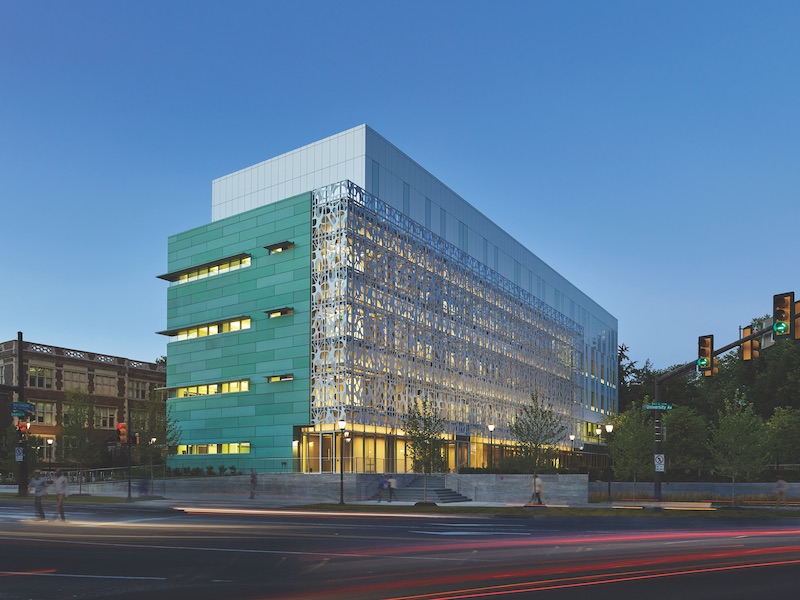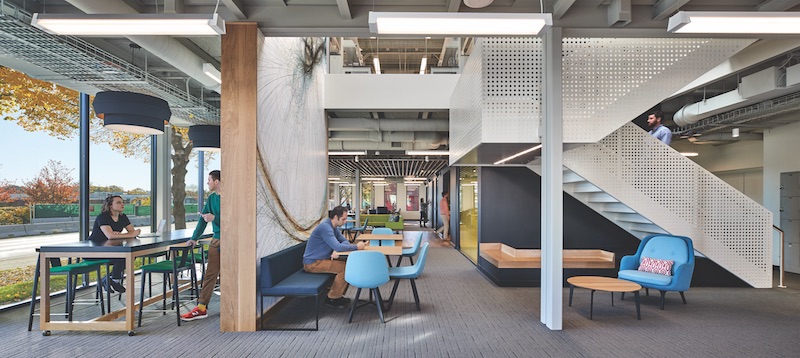Makerspaces and interdisciplinary mashups are connecting students with each other—and with the outside world.
Students at the University of Utah can choose to live in an on-campus environment that’s immersed in discovery and entrepreneurship. The 400-bed Lassonde Studios residential hall features a 20,000-sf innovation space where residents can test ideas, build prototypes, and launch companies. Designed by CannonDesign’s Yazdani Studio, in association with EDA Architecture, the building reflects a broader trend toward hands-on spaces that encourage students to collaborate within and beyond the physical campus.
“Universities are increasingly interested in the commercialization of technologies or research that offer opportunities to partner with the private sector,” says Don Hensley, VP and Education Sector Leader (U.S. West) with Stantec.
The Center for the Sciences & Innovation at Trinity University, San Antonio, designed by EYP Architecture & Engineering, features “The Cube,” a high-performance makerspace with movable walls, mobile team stations, and gigantic garage doors to support entrepreneurial interaction among students and faculty.
“There’s increased demand for spaces that physically bring students together—across disciplines—to work collaboratively on a wide variety of creative projects,” says John Baxter, AIA, LEED AP, Higher Education Sector Leader at EYP. “These specialized makerspaces elevate hands-on, project-based learning and provide experiential opportunities within a structured, mentored environment.”
Today’s multi-functional buildings support a diverse range of academic programs, with transparent walls to foster interdisciplinary collaboration. “The idea is to literally and figuratively break down the walls between departments so that students and faculty are working together more consistently and organically,” says Hensley.
A nationwide focus on science and technology buildings is helping universities compete for researchers and grants, as well as to increase their enrollment of students pursuing degrees in science, technology, engineering, and math.
The new Yale Science Building is designed with flexible laboratories to accommodate interdisciplinary research in molecular, cellular, and developmental biology; molecular biophysics and biochemistry; and atomic, molecular, and optical physics. Pelli Clarke Pelli Architects and Stantec collaborated on the seven-story, 300,000-sf building, which will be constructed in the campus’s Science Hill precinct.
 Adorned with a biomorphic aluminum sunscreen that shades the curtain wall on the south side of the building, the 78,000-sf Stephen A. Levin Building at the University of Pennsylvania integrates psychology, biology, and behavioral sciences under one roof with research laboratories, teaching facilities, and collaboration and study spaces. Photo: Alan Karchmer.
Adorned with a biomorphic aluminum sunscreen that shades the curtain wall on the south side of the building, the 78,000-sf Stephen A. Levin Building at the University of Pennsylvania integrates psychology, biology, and behavioral sciences under one roof with research laboratories, teaching facilities, and collaboration and study spaces. Photo: Alan Karchmer.
experimenting with novel funding SOLUTIONS
Public and private universities are looking for money—and cost savings—anyplace they can. “Institutions are turning to external partners to deliver financial, construction, and operating solutions to their housing and other student life needs, and they’re also looking at public-private partnerships to meet their research and academic facilities needs,” says Eric Beattie, PE, LEED BD+C AP, Leader of the Higher Education Center of Excellence at Gilbane Building Co.’s Boston office.
The Agricultural Engineering Building under construction at Penn State University is the school’s first project to be delivered using integrated project delivery. Architect EYP, contractor DPR Construction, and the university are sharing equally in the project’s risks and rewards.
Prefabrication is proving to be an efficient, eco-friendly construction method. At the University of Virginia, Barton Malow is overseeing the renovation of a half-dozen four-story residential buildings originally constructed in the 1950s. “We’re collaborating with multiple trades to create modular prefab piping and mechanical rooms, which will help accelerate production and installation time and improve job site safety,” says Barton Malow Vice President Todd Ketola.
Advanced technology is also helping to optimize construction quality and efficiency at Washington University in St. Louis. McCarthy Building Cos. is using drones to take aerial measurements of the excavation site on the multi-building campus expansion; 4D scheduling technology will provide the construction crew and subcontractors with real-time progress of the concrete installations and MEP systems during the two-year project.
“While the project is comprised of multiple buildings and landscape elements that each have a unique design and function, it’s important that it function as a single project from a construction standpoint,” says McCarthy Project Director Ryan Moss.
Some universities are focusing on the renovation and reuse of signature buildings to enhance the functionality of the core campus while maintaining the institution’s overall character and identity. The University of Notre Dame Campus Crossroads project, the largest building initiative in the university’s 174-year history, is designed around the legendary Notre Dame Stadium, which is being renovated and expanded. Three new buildings will surround the storied football edifice, creating more than 750,000 sf of teaching, research, performance, meeting, and hospitality space.
ALSO SEE: BD+C GIANTS 300 UNIVERSITY RANKINGS
Top 110 university architecture firms
Top 55 university engineering firms
Top 95 university construction firms
Traditional higher education institutions are also facing growing competition from lower-cost alternatives, such as so-called MOOCs (massive open online courses) and other alternative models. “As universities compete with the convenience of online learning, there is great focus on finding ways to engage the student. Face-to-face interaction, hands-on learning, and hybrid learning offer an on-campus experiential element that students can’t get from the Internet,” says Stantec’s Hensley.
“The cost of education has risen much faster than the cost of living, and the current rate of increase is not sustainable,” says David Hatton, AIA, Director of Education, CannonDesign. “Creative entrepreneurs are starting to fill the gap with lower-priced, customizable educational platforms that provide an equivalent level of education. Traditional colleges will need to adapt in order to separate themselves from this new competition.”
SEE ALL 2017 GIANTS 300 RANKINGS
Related Stories
Adaptive Reuse | Sep 19, 2023
Transforming shopping malls into 21st century neighborhoods
As we reimagine the antiquated shopping mall, Marc Asnis, AICP, Associate, Perkins&Will, details four first steps to consider.
Giants 400 | Aug 22, 2023
Top 115 Architecture Engineering Firms for 2023
Stantec, HDR, Page, HOK, and Arcadis North America top the rankings of the nation's largest architecture engineering (AE) firms for nonresidential building and multifamily housing work, as reported in Building Design+Construction's 2023 Giants 400 Report.
Giants 400 | Aug 22, 2023
2023 Giants 400 Report: Ranking the nation's largest architecture, engineering, and construction firms
A record 552 AEC firms submitted data for BD+C's 2023 Giants 400 Report. The final report includes 137 rankings across 25 building sectors and specialty categories.
Giants 400 | Aug 22, 2023
Top 175 Architecture Firms for 2023
Gensler, HKS, Perkins&Will, Corgan, and Perkins Eastman top the rankings of the nation's largest architecture firms for nonresidential building and multifamily housing work, as reported in Building Design+Construction's 2023 Giants 400 Report.
Higher Education | Aug 22, 2023
How boldly uniting divergent disciplines boosts students’ career viability
CannonDesign's Charles Smith and Patricia Bou argue that spaces designed for interdisciplinary learning will help fuel a strong, resilient generation of students in an ever-changing economy.
Adaptive Reuse | Aug 17, 2023
How to design for adaptive reuse: Don’t reinvent the wheel
Gresham Smith demonstrates the opportunities of adaptive reuse, specifically reusing empty big-box retail and malls, many of which sit unused or underutilized across the country.
Higher Education | Aug 7, 2023
Building a better academic workplace
Gensler's David Craig and Melany Park show how agile, efficient workplaces bring university faculty and staff closer together while supporting individual needs.
University Buildings | Aug 7, 2023
Eight-story Vancouver Community College building dedicated to clean energy, electric vehicle education
The Centre for Clean Energy and Automotive Innovation, to be designed by Stantec, will house classrooms, labs, a library and learning center, an Indigenous gathering space, administrative offices, and multiple collaborative learning spaces.
Market Data | Aug 1, 2023
Nonresidential construction spending increases slightly in June
National nonresidential construction spending increased 0.1% in June, according to an Associated Builders and Contractors analysis of data published today by the U.S. Census Bureau. Spending is up 18% over the past 12 months. On a seasonally adjusted annualized basis, nonresidential spending totaled $1.07 trillion in June.
Market Data | Jul 24, 2023
Leading economists call for 2% increase in building construction spending in 2024
Following a 19.7% surge in spending for commercial, institutional, and industrial buildings in 2023, leading construction industry economists expect spending growth to come back to earth in 2024, according to the July 2023 AIA Consensus Construction Forecast Panel.

















